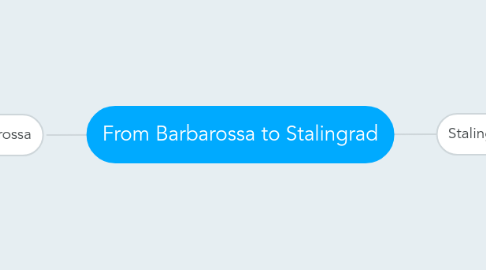
1. Barbarossa
1.1. Important Dates
1.1.1. June 22nd, 1941: German armies poured into the Soviet Union and crushed Soviet army and air forces in their path in an operation called Barbarossa.
1.1.2. Since 1940, Stalin had delivered a million tons of mineral oil, 2700 kg of platinum, and quantities of magnesium, chrome, and cotton to the value of 239 million marks as part of a negotiated trade agreement with the Nazis.
1.1.3. December 5th, 1941: German troops were almost successful in closing the gap behind Moscow, but at that critical juncture, they ran out of supplies.
1.1.4. December 8th, 1941: The German Army shifted to winter-operations status and gave up the attack.
1.2. Military Statistics
1.2.1. Germany
1.2.1.1. 6000 guns
1.2.1.2. 3 million soldiers
1.2.1.3. 6000 vehicles
1.2.1.4. 750 000 horses
1.2.1.5. 1830 aircraft
1.2.2. USSR
1.2.2.1. 4.5 million soldiers
1.2.2.2. 2000 airplanes
1.3. Reasons for Attacking
1.3.1. Needed farmland from Ukraine and oil resources from the Caucasus
1.4. Short-Term Results
1.4.1. Took the pressure off of Britain
1.5. Long-Term Effects
1.5.1. Contributed to Nazi destruction in World War II
1.6. Major Events
1.6.1. Germany had control of the air after 24 hours
1.6.2. Soviet positions were photographed
1.6.3. Rail and road bridges at Dvinsk captured
1.6.4. 200 Soviet Divisions annihilated after first days of assault
1.7. Technology
1.7.1. Aircraft
1.7.2. Tanks
1.7.3. Guns
1.8. Leaders
1.8.1. General Pavlov
1.8.2. General Yeremko
2. Stalingrad
2.1. Important Dates
2.1.1. Spring, 1942: The Germans their offensive toward Stalingrad on the Volga River
2.1.2. September 1942: The bombing of the city of Stalingrad
2.1.3. November 1942: Germans penetrated the Volga River at several points
2.1.4. November 1942: Soviets attack along German flanks
2.1.5. December 1942: Soviets cut off Stalingrad from the outside
2.1.6. February 22, 1943: The Germans surrendered
2.1.7. 1943: USSR's counter-offensive to Germany after Stalingrad victory
2.2. Leaders
2.2.1. Freidrich Paulus (German Sixth Army)
2.2.2. General Zhukov
2.3. Military Statistics
2.3.1. USSR
2.3.1.1. 270 000 soldiers
2.3.1.2. 40 000 aircraft
2.3.1.3. 30 000 tanks
2.3.1.4. 50 000 pieces of artillery
2.3.1.5. 500 000 machine guns
2.3.2. Germany
2.3.2.1. 270 000 soldiers
2.3.2.2. 500 tanks
2.3.2.3. 3000 artillery
2.3.2.4. 600 aircrafts
2.4. Technology
2.4.1. Aircraft
2.4.2. Tanks
2.4.3. Artillery
2.4.4. Machine Guns
2.5. Reasons for Attacking
2.5.1. Stalingrad was a strategic transportation and communication hub. Its capture would cut off the land route carrying British and American supplies to the Soviets and provide the Germans with a base for attacks on the east of the Ural Mountains
2.6. Major Events
2.6.1. The first bombing occurs in September
2.6.2. Field Marshal Paulus level the southern part of the city for the next four months
2.6.3. The city was taken in flames in fierce house-to-house fighting.
2.6.4. Germans penetrated the Volga River at several points, but weren’t able to silence the Soviet artillery on the northern bank.
2.6.5. Soviets complete a pincer movement by striking deep behind German lines and cuts off Stalingrad from the outside.
2.6.6. Germans surrender when the Luftwaffe was unable to bring in the 500 tons of daily supplies required.
2.7. Short-Term Results
2.7.1. 90 000 German soldiers taken into captivity
2.7.2. Large loss of manpower and equipment on both sides
2.8. Long-Term Results
2.8.1. At this point, Germany had lost the war on the Eastern Front
2.9. Interesting Facts
2.9.1. The German army had surrendered because the Luftwaffe delivered exponentially few supplies to them. They were meant to deliver 500 tons, but the largest delivery in this battle was 65 tons.
2.9.2. The Ural Mountains is where most of the Soviet Union’s equipment was manufactured.
2.9.3. This battle was a major turning point of World War II.
